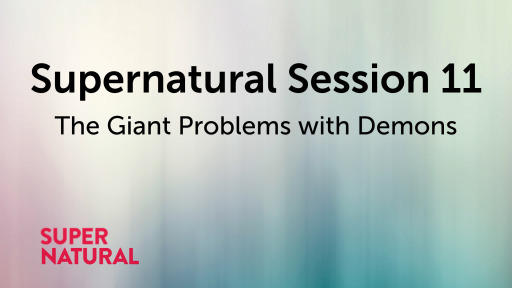Supernatural Session 11 (The Giant Problems with Demons)

GIANT PROBLEMS
NEPHILIM BEFORE THE FLOOD
NEPHILIM AFTER THE FLOOD
THE GIANTS OF THE TRANSJORDAN
THE UNSEEN COMBATANTS: General Terminology
We saw earlier that the Hebrew Bible uses the term elohim to speak of any inhabitant of the spiritual world. The word itself provides no differentiation among beings within that realm, though hierarchy is certainly present. Yahweh, for example, is an elohim, but no other elohim is Yahweh. Nevertheless, the term elohim tells us very little about how an ancient reader would have parsed the pecking order of the unseen realm. The same is true of certain Greek terms that are used in the New Testament.
When the subject of spiritual warfare surfaces, most students of Scripture think of angels and demons. Those terms are very broad and don’t shed a great deal of light on how New Testament writers thought of rank and power in the unseen world.
There are roughly 175 references to angels in the New Testament (aggelos/angelos). Like the Hebrew counterpart (malʾak), the term means “messenger.” Fundamentally, the term describes a task performed by a divine being, not what a divine being is.
The use of the term angelos increased in the Second Temple period on through the New Testament so that its meaning became more generic, akin to daimonion. That is, it can be found on occasion outside the context of delivering a message in descriptions of a group of divine beings (e.g., Luke 15:10).
This widening of the term’s semantics is shown in Hebrews 1:4–5; 2:7–9. In the second of these passages, the word angelos is used when the writer quotes Psalm 8:4–6, so that Hebrews 2:7 describes humankind as being “a little lower than the angels,” whereas the Hebrew text of Psalm 8:5 has humanity being “a little lower than elohim.” While the original Hebrew text could mean that humankind was created “a little lower than God [elohim],” the Greek translation that the writer of Hebrews is using (the Septuagint) interpreted elohim as plural, and translated the word with angeloi (“angels”). This shows us that angelos had become a word deemed appropriate to generally describe a member of the supernatural realm, just as elohim is used in the Old Testament.
The two Greek terms translated “demon” in the New Testament are daimōn and daimonion. Our word “demon” is actually a transliteration of the Greek, not a translation. In classical Greek literature, which preceded the time of the New Testament, the term daimōn describes any divine being without regard to its nature (good or evil). A daimōn can be a god or goddesss, some lesser divine power, or the spirit of the departed human dead. As such, it is akin to Hebrew elohim in its generic meaning.
The New Testament is silent on the origin of demons. There is no passage that describes a primeval rebellion before Eden where angels fell from grace and became demons. The origin of demons in Jewish texts outside the Bible (such as 1 Enoch) is attributed to the events of Genesis 6:1–4. When a Nephilim was killed in these texts, its disembodied spirit was considered a demon. These demons then roamed the earth to harass humans. The New Testament does not explicitly embrace this belief, though there are traces of the notion, such as demon possession of humans (implying the effort to be re-embodied).
Not surprisingly, in the New Testament, the terms daimōn and daimonion are nearly always used negatively. That is, they refer to evil, sinister powers.8 This is likely due to the use of the terms in the Septuagint, though the influence of Second Temple Judaism may be a factor. The Septuagint translators use daimōn once (Isa 65:11) of a foreign god. Daimonion occurs nine times to refer to idols (e.g., Psa 96:5 [Septuagint: 95:5]) and foreign gods of the nations whom Israel was not to worship (e.g., Psa 91:6 [Septuagint: 90:6]).
In the New Testament, the verb equivalents to these nouns (daimonao, daimonizomai) refer to being possessed by a daimōn and are always negative. Daimonion occurs in parallel to “unclean spirit” in several passages (e.g., Luke 8:29; 9:42; cf. Luke 4:33).
Oddly enough, only one verse in the Bible mentions Satan and demons together: “So if Satan also is divided against himself, how will his kingdom stand? For you say that I expel demons by Beelzebul” (Luke 11:18). The verse strongly implies that Satan has authority over demons, but does not make it clear that all demons are under his authority or how this authority emerged. The Old Testament is silent on the matter since the noun saṭan was not a proper name and was not used of the enemy in the garden.